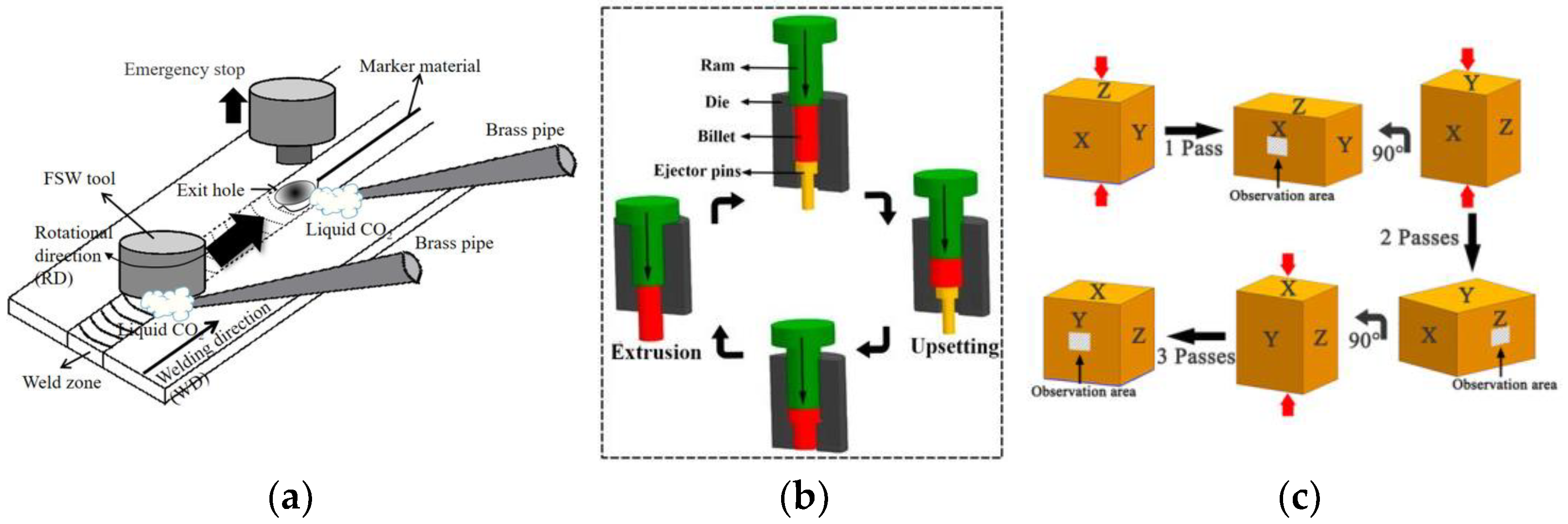Dynamic Recrystallization Behaviours in Metals and Alloys
Conflicts of Interest
References
- Stüwe, H.P. Do metals recrystallize during hot working? In Deformation under Hot Working Conditions; Tegart, W.J.M., Sellars, C.M., Eds.; ISI Special Report 108; Iron and Steel Institute: London, UK, 1968; pp. 1–6. [Google Scholar]
- Thomsen, E.G.; Yang, C.T.; Bierbower, J.B. An Experimental Investigation of the Mechanics of Plastic Deformation of Metals; University of California Press: Berkeley, CA, USA, 1954. [Google Scholar]
- Jonas, J.J. Dynamic recrystallization—Scientific curiosity or industrial tool? Mater. Sci. Eng. A 1994, 184, 155–165. [Google Scholar] [CrossRef]
- Huang, K.; Logé, R.E. A review of dynamic recrystallization phenomena in metallic materials. Mater. Design 2016, 111, 548–574. [Google Scholar] [CrossRef]
- Nagira, T.; Liu, X.; Ushioda, K.; Fujii, H. Microstructural evolutions of 2N grade pure Al and 4N grade highpurity Al during friction stir welding. Materials 2021, 14, 3606. [Google Scholar] [CrossRef] [PubMed]
- Wu, G.; Yu, J.; Jia, L.; Xu, W.; Dong, B.; Zhang, Z.; Hao, B. Microstructure and texture evolution of Mg-Gd-Y-Zr alloy during reciprocating upsetting-extrusion. Materials 2020, 13, 4932. [Google Scholar] [CrossRef] [PubMed]
- Liu, H.; Meng, Y.; Yu, H.; Xu, W.; Zhang, S.; Jia, L.; Wu, G. The role of long period stacking ordered phase in dynamic recrystallization of a Mg-Gd-Y-Zn-Zr alloy during multi-directional forging process. Materials 2020, 13, 3290. [Google Scholar] [CrossRef] [PubMed]
- Dolzhenko, P.; Tikhonova, M.; Kaibyshev, R.; Belyakov, A. Pecularities of DRX in highly-alloyed austenitic stainless steel. Materials 2021, 14, 4004. [Google Scholar] [CrossRef] [PubMed]
- Lei, Y.; Yang, Y.; Tan, Y.; Zhang, W.; Wu, S.; Ma, M. Effect of hot working parameters on microstructure and texture evolution of hot-deformed Zr-45Ti-5Al-3V alloy. Materials 2022, 15, 1382. [Google Scholar] [CrossRef] [PubMed]
- Zhou, D.; Gao, H.; Guo, Y.; Wang, Y.; Dong, Y.; Dan, Z.; Chang, H. High temperature deformation behavior and microstructural characterization of Ti-35421 titanium alloy. Materials 2020, 13, 3623. [Google Scholar] [CrossRef] [PubMed]
- Buzolin, R.H.; Miller Branco Ferraz, F.; Lasnik, M.; Krumphals, A.; Poletti, M.C. Improved predictability of microstructure evolution during hot deformation of titanium alloys. Materials 2020, 13, 5678. [Google Scholar] [CrossRef] [PubMed]
- Ullmann, M.; Kittner, K.; Prahl, U. Hot deformation and dynamic recrystallization behavior of twin-roll cast Mg-6.8Y-2.5Zn-0.4Zr magnesium alloy. Materials 2021, 14, 307. [Google Scholar] [CrossRef] [PubMed]
- Montheillet, F. Influence of boundary migration softening on the steady state of discontinuous dynamic recrystallization. Materials 2021, 14, 3531. [Google Scholar] [CrossRef] [PubMed]


Disclaimer/Publisher’s Note: The statements, opinions and data contained in all publications are solely those of the individual author(s) and contributor(s) and not of MDPI and/or the editor(s). MDPI and/or the editor(s) disclaim responsibility for any injury to people or property resulting from any ideas, methods, instructions or products referred to in the content. |
© 2023 by the author. Licensee MDPI, Basel, Switzerland. This article is an open access article distributed under the terms and conditions of the Creative Commons Attribution (CC BY) license (https://creativecommons.org/licenses/by/4.0/).
Share and Cite
Montheillet, F. Dynamic Recrystallization Behaviours in Metals and Alloys. Materials 2023, 16, 976. https://doi.org/10.3390/ma16030976
Montheillet F. Dynamic Recrystallization Behaviours in Metals and Alloys. Materials. 2023; 16(3):976. https://doi.org/10.3390/ma16030976
Chicago/Turabian StyleMontheillet, Frank. 2023. "Dynamic Recrystallization Behaviours in Metals and Alloys" Materials 16, no. 3: 976. https://doi.org/10.3390/ma16030976
APA StyleMontheillet, F. (2023). Dynamic Recrystallization Behaviours in Metals and Alloys. Materials, 16(3), 976. https://doi.org/10.3390/ma16030976




